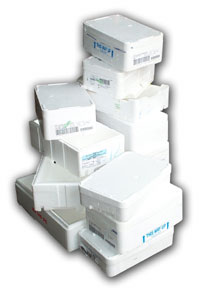How is Polystyrene (styrofoam)
made?
Polystyrene (styrofoam) is extracted from oil. Thousands
of small units of styrene, called monomers, link together
to form large molecules of polystyrene by a process called
polymerisation.
Expanded polystyrene starts as small spherical beads with a typical diameter of 0.5-1.5mm. They contain an expanding agent; a pure hydrocarbon, which does not contain any halogens and does not damage the earth's protective ozone layer.
When the beads are heated with steam, the agent starts to boil, the polymer softens and the beads expand to about forty times their initial size. After a maturing period to equilibrate temperature and pressure, the pre-foamed beads, which now have a closed cellular foam structure, are placed in a mould and again reheated with steam.
The mould can be designed to meet any requirements of the customer. The pre-foamed beads expand further, completely fill the mould cavity and fuse together. When moulded, nearly all the volume of the EPS foam (in fact 98%) is air. This is what makes EPS so lightweight and buoyant.
Uses of Polystyrene:
Polystyrene products include both food service packaging (cups, plates, bowls, trays, clamshells, meat trays, egg cartons, yogurt and cottage cheese containers, and cutlery) and protective packaging (shaped end pieces used to ship electronic goods and loose fill "peanuts"
How to recycle polystyrene (styrofoam)... |

Polystyrene (styrofoam) is highly
versatile and can be
recycled using a
Styromelt™ system. |